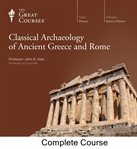Nonfiction
eAudiobook
Details
PUBLISHED
Made available through hoopla
EDITION
DESCRIPTION
1 online resource (1 audio file (1080 min.)) : digital
ISBN/ISSN
LANGUAGE
NOTES
Lecturer: John R Hale
Over the years, Classical archaeology has evolved from a pastime of collectors and antiquarians to a mature science. Today, the field is a multidisciplinary effort that involves not only traditional diggers, but also geologists, geographers, anthropologists, and linguists. These 36 lectures introduce you to this fascinating field of study. Professor Hale guides you through dozens of ancient sites with the skill of a born storyteller. The riveting narrative unfolds like a series of detective stories and provides a new perspective from which to view the world of the Greeks and Romans, resurrecting them in all their glory and affording us a better grasp of cultures that have greatly influenced our own. A series of exciting archaeological sites that provides you with a detailed idea of what Classical archaeology entails, as well as insights into the details of ancient Greek and Roman life. These case studies - involving both famous sites and discoveries unknown outside the field - include the city of Troy, the Athenian Agora, and the Cape Gelidonya Shipwreck. Through an analysis of these and other riveting sites, you get a superb sampling of Classical archaeology and learn how it combines ancient history, anthropology, ethnography, comparative religion, art history, engineering, historical linguistics, paleobotany, and other pursuits with a dash of Indiana Jones-style adventure. Mysteries abound in this course, and in the end, you'll view the world of the Greeks and Romans not as a sequence of historical events but as an immense living organism; a system in which society, culture, and the natural environment interact in dynamic, creative, and sometimes destructive ways
Mode of access: World Wide Web







